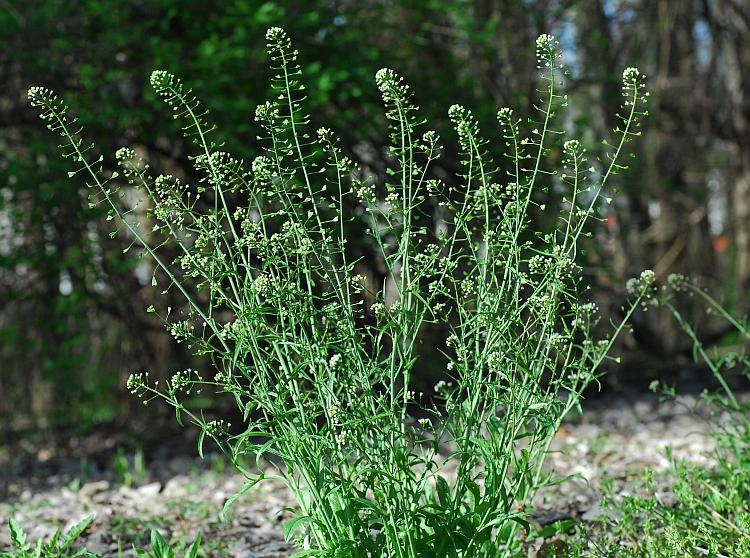Capsella bursa-pastoris (L.) Medik.
Shepherd's Purse

Introduced
CC = *
CW = 3
MOC = 79
© SRTurner
Capsella bursa-pastoris (L.) Medik.Shepherd's Purse | |
 |
Introduced CC = * CW = 3 MOC = 79 |
© SRTurner |
|
Family - Brassicaceae Habit - Taprooted annual forb. Stem - Weakly ascending to erect, to 70 cm, often multiple from base, sometimes sparsely branched, pubsecent with sessile stellate, stalked forked, and simple hairs, mostly toward the base.
Leaves - Basal and alternate. Basal leaves numerous, petiolate, the blades oblanceolate, irregularly toothed and/or pinnatifid. Stem leaves relatively few, reduced upward, mostly sessile and clasping with prominent auricles, lanceolate to linear, entire or shallowly toothed or lobed, pubescence as with basal leaves.
Inflorescences - Terminal racemes, greatly elongating in fruit, the lower branches sometimes subtended by reduced leaves.
Flowers - Sepals 4, 1-2 mm long, ascending, elliptic, usually sparsely pubescent, sometimes with white or reddish purple margins. Petals 4, 2-4 mm long, not lobed, white. Styles 0.2-0.7 mm long. Stamens 6, with 2 shorter than other 4. Ovary 1 per flower, superior, of 2 fused carpels, usually with 2 locules. Style 1 per flower, persistent in the fruits, the stigma 1, entire. Ovules numerous.
Fruits - Silicles, spreading to ascending, 4-8 mm long, about as long as wide, obtriangular, flattened at a right angle to the septum, the tip usually slightly concave, dehiscing longitudinally, each valve with a network of nerves. Seeds 8-20 in each locule, 0.8-1.1 mm long, oblong in outline, the surface with a fine, netlike or honeycomb-like pattern of ridges and pits, orangish yellow
Flowering - January - December. Habitat - Pastures, fields, lawns, roadsides, railroads, nearly any open, disturbed area. Origin - Native to Eurasia. Lookalikes - Thlaspi arvense, several species of Lepidium. Other info. - This is one of the earlier plants to flower in spring, and in fact can be found blooming sporadically at any month of the year. It is extremely common, and is probably present in every county of Missouri and every state of the U.S. Although there are several lookalikes, this species can be positively identified by its unique triangular fruits. Photographs taken in Washington, Franklin County, MO, 4-29-2018; and near Villa Ridge, Franklin County, MO, 4-07-2023 (SRTurner). |